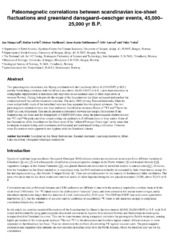Paleomagnetic correlations between scandinavian ice-sheet fluctuations and greenland dansgaard–oeschger events, 45,000–25,000 yr B.P.
Mangerud, Jan; Løvlie, Reidar; Gulliksen, Steinar; Hufthammer, Anne Karin; Larsen, Eiliv; Valen, Vidar
Peer reviewed, Journal article
Permanent lenke
https://hdl.handle.net/1956/405Utgivelsesdato
2003Metadata
Vis full innførselSamlinger
Originalversjon
https://doi.org/10.1016/s0033-5894(03)00010-3Sammendrag
Two paleomagnetic excursions, the Skjong correlated with the Laschamp (about 41,000 GISP2 yr B.P.) and the Valderhaug correlated with the Mono Lake (about 34,000 GISP2 yr B.P.), have been identified in stratigraphic superposition in laminated clay deposited in ice-dammed lakes in three large caves in western Norway. During both periods the margin of the Scandinavian Ice Sheet advanced and reached the continental shelf beyond the outermost coastline. The mild, 4000-yr-long Ålesund interstade, when the coast and probably much of the hinterland were ice-free, separated the two glacial advances. The two paleomagnetic excursions have also been indirectly identified as increased fluxes of 36Cl and 10Be in the GRIP ice core, Greenland. This article presents a correlation between ice-margin fluctuations of the Scandinavian Ice Sheet and the stratigraphy of GRIP/GISP cores, using the paleomagnetic excursions and the 36Cl and 10Be peaks and thus circumventing the application of different dates or time scales. Some of the fluctuations of the Scandinavian Ice Sheet were of the "Allerød/Younger Dryas type" in the sense that its margin retreated during mild interstades on Greenland and readvanced during cold stades. However, some fluctuations were apparently not in phase with the Greenland climate.
